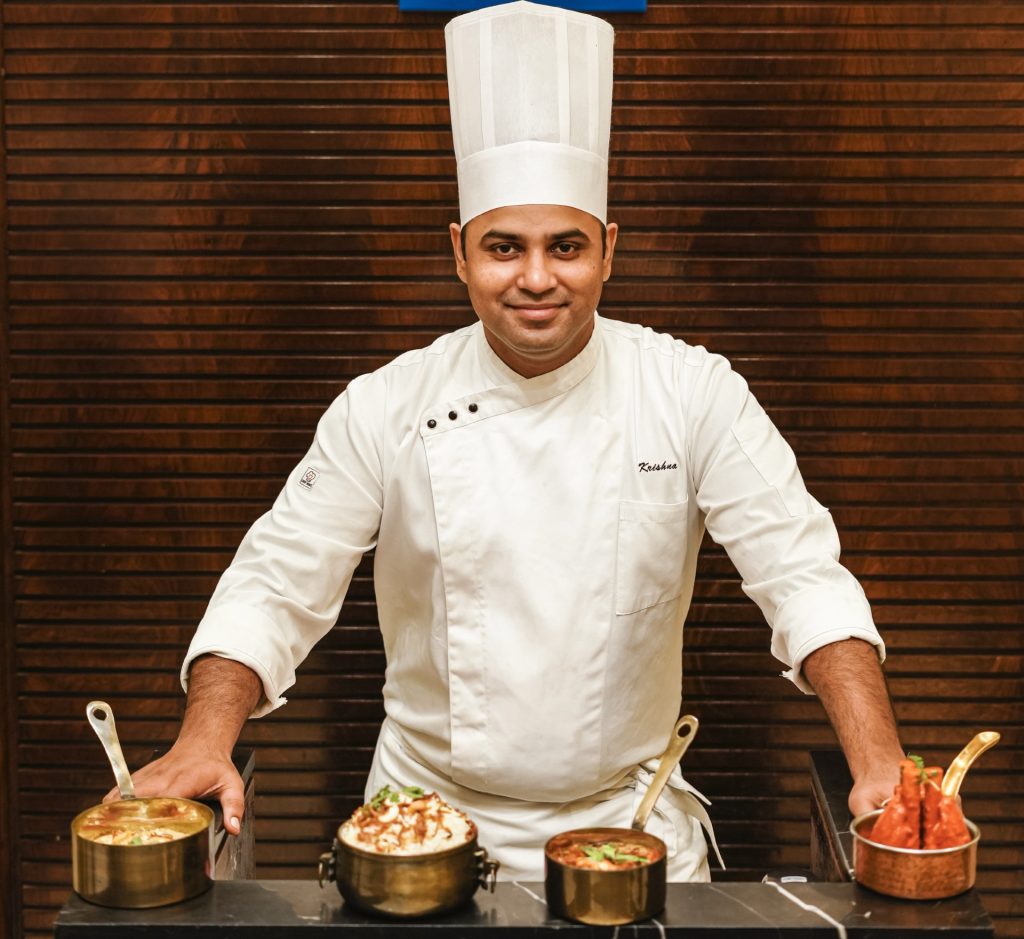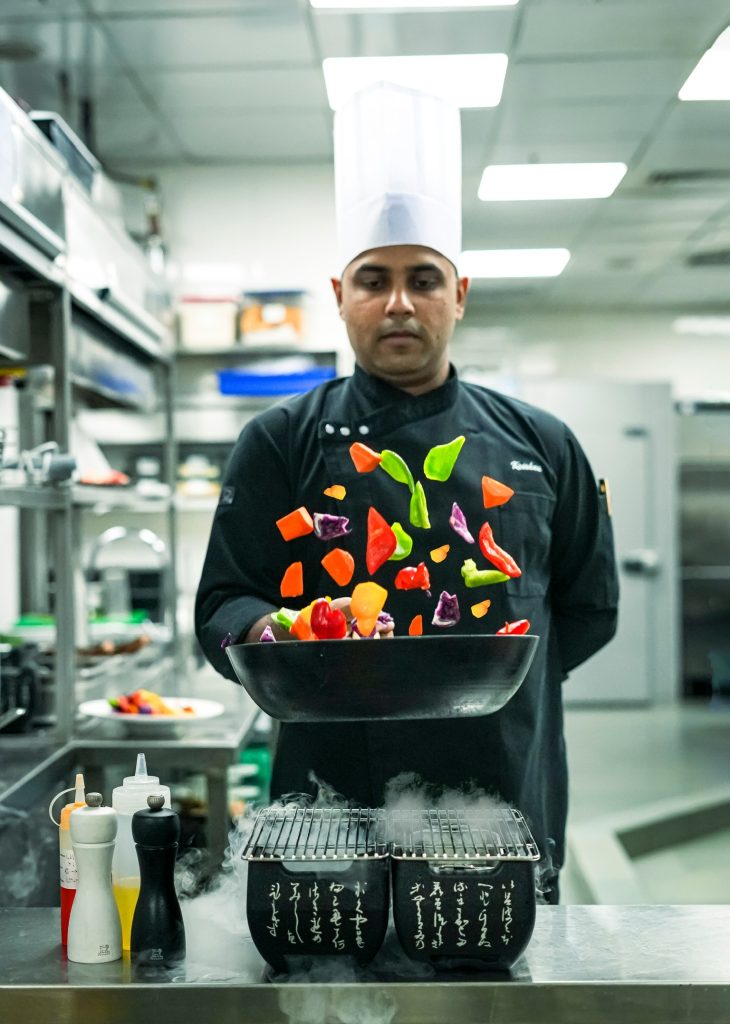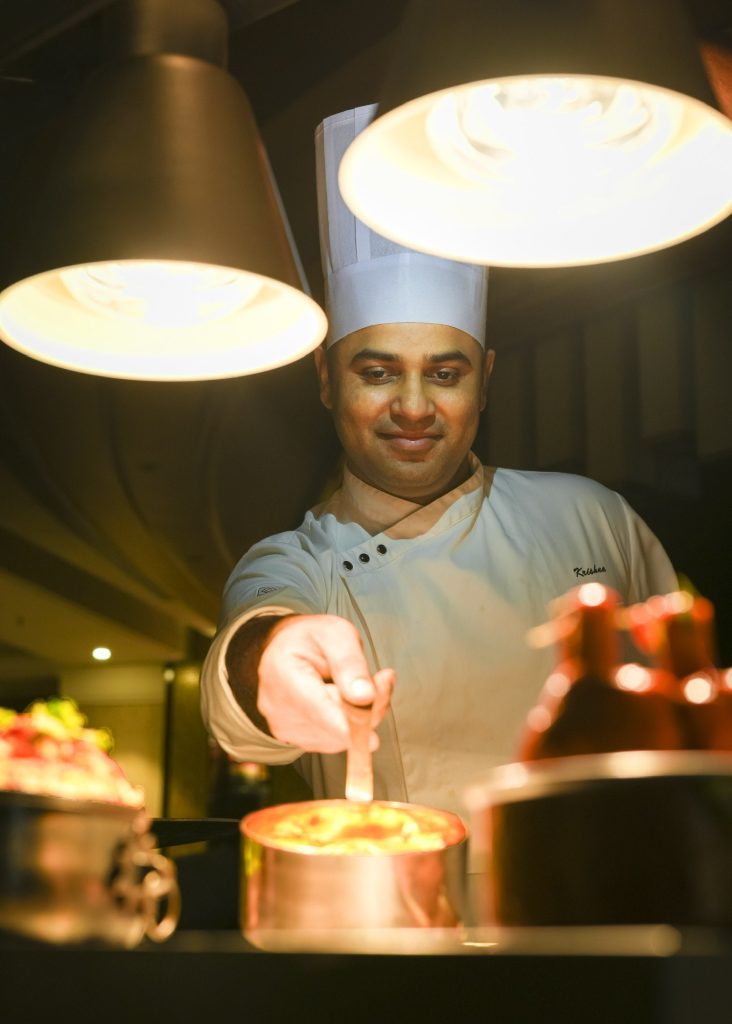The depth of Indian cuisine with French finesse are given a modern interpretation by Chef Krishna Chaithanya, the Chef De Cuisine at Zila in Hyderabad.
“The food I make represents my entire culinary journey thus far; it is parts of everywhere I have been,” says Krishna Chaithanya, Chef De Cuisine at Zila – the progressive, upmarket restaurant in the Knowledge City area of Hyderabad. And he has been around the block – working at several legendary brands with Michelin starred chefs. Each time, the urge to move has been spurred by wanting to get creative with what he did. And the learning offered with these moves now reflect in the gourmet food with an Indian heart that he makes.
An early start
On paternity leave at the time of the interview, Chef Krishna’s family friends and cousins are associated with the Vellanki Foods and the Rameshwaram Café brands. Several others owned tiffin centres and messes which served simple, wholesome fare. He recalls, “I was exposed to the restaurant and food business even during school, when I would go to help out in the absence of a staffer. Though my parents wanted me to take up engineering, I chose to go to culinary school. I joined the Culinary Academy of Hyderabad and my parents saw the change in me. I was more driven and focussed. For my first internship I chose ITC Park Sheraton, now the Crowne Plaza, in Chennai, as I wanted to explore life and food outside Hyderabad. I would explore the food and neighbouring areas like Puducherry.”

Chef Krishna Chaithanya is the Chef de Cuisine at Zila in Hyderabad
Chef Krishna joined the Taj Krishna Hyderabad, after completing his course, as a hotel operations management trainee. This was his base for four years and he worked at Firdaus, their Indian restaurant, and Encounters and Alfresco, the all-day diner. This was followed by a short stint at Barbecue Nation, setting up their flagship outlet, and then Taj Krishna again as for what was to be a short stint. In the midst of all this, in 2017, he was part of a team that was sent to Davos, Switzerland, as part of the Andhra Pradesh entourage for the World Economic Forum. His job was to cook Andhra food through the day – from breakfast to lunch to high tea for the delegates who visited their stall called Sunrise Café. From Prime Minister Narendra Modi to then AP CM Chandrababu Naidu and several world leaders, they all sampled the food he had made.
Michelin Stars and more
Then, a call from a friend in Bangkok led Chef Krishna to the kind of creative environment he craved. Gaggan Anand, the Michelin star chef wanted to speak to him. He recalls, “It was past midnight and Chef Gaggan called; all he asked me was whether I could make idlis, dosas and upma. I said yes and he asked me to come to Bangkok as he was looking for someone with my skill set. It was barely five months after I had rejoined the Taj and this was an offer of a lifetime. There is no culture of holding back anyone at the Taj, so I decided to go to Bangkok despite misgivings from my family and girlfriend.”
Moving to Thailand and specifically, working with Gaggan Anand was, for Chef Krishna “an experience like that of a kid in a candy shop. There was so much equipment I had never seen before – where a carrot would go in at one end and come out as paper at the other. It felt like a miracle and took a week for it to sink in. I finally felt like this is what creativity should be. The usage and understanding of food at a molecular level, playing around with textures of dishes and learning the attitude of ‘why not’ were my biggest takeaways here.”
Unfortunately for Chef Krishna, after three months, due to some differences between the investors and Chef Gaggan, the restaurant closed down and he chose to go with the investors who wanted to start something new. The core team was sent to India to explore the cuisines they specialised in before the launch. While he was here, he got the opportunity to work at Karavalli, at the Taj Gateway in Bengaluru, which strengthened the foundation of his knowledge of South Indian cuisine. “I travelled to Chennai, all over Karnataka, sampled several dishes and found out how they were originally made. It was like a research trip. Then, as we entered Bangkok the lockdown began and five or six of us were cooped up in an apartment. We started experimenting with dishes and creating new ones for the restaurant. The investor, Rajesh Kewalramani, wanted us to capture the finesse of European food and add it to the depth that Indian food already had.”

The restaurant they helped set up is now called Indee, and it has recently been awarded a Michelin star. Again, Chef Krishna had to move, this time for personal reasons. On his return to India, he joined the Sheraton Grand in Pune where he was in charge of creating the menu for global cuisine at their restaurant Nuvo, which was a fine dining restaurant in the evening and after 11 pm, it turned into a high energy nightclub. He says, “Here I had the freedom to do anything with the food and while it was creatively a great step, I still missed Indian cuisine. After a year, I got the offer to move to Hyderabad with Zila and I took it up because we were expecting our first baby and it made sense to be close to family.”
At home with contemporary trends
At Zila, Chef Krishna Chaithanya seems to have finally found his groove. Indian food is given the finesse of presentation like European food. Its soul is essentially Indian and experimentation is within those parameters. Chef Krishna explains, “We make a kachumber which looks nothing like what it traditionally is. It is a constructed salad with stracciatella topped with cured cucumbers in sake, mirin apple cider vinegar and black salt, then arranged with sliced heirloom tomatoes topped with a smoked tomato and date chutney. Then we add a dollop of our chunky mint chutney to bring all the ingredients together. To make it sustainable we make a juice out of all the trimming of vegetables and season and foam it up and serve it on the side. This is in keeping with the global trend of sustainability, as it has zero wastage.”
With so much thought going into a salad, other dishes get similar respect. With Rogan Josh, instead of mutton, he uses lotus stem, which is also native to Kashmir. “The easiest option to replace meat with a vegetable is raw jackfruit. I wanted to move away from that and try something else. It has become one of our most ordered dishes.”
In a nutshell, Chef Krishna Chaithanya reiterates that at Zila, they are elevating age old recipes, giving them a modern touch without losing out on the soul of the dish. A kulcha comes stuffed with brie and bird’s eye chillies, topped with aragula leaves, and the raw mango and cranberry chunda is a marriage between an Amritsari kulcha and a French puff pastry to give it a crunch.

And while he thinks he is still a long way from having the expertise of writing his own cookbook, he believes that sustainability and conscious eating are the zeitgeist now. “People are more aware of what they eat; our customers even ask us about the source of our ingredients. We try and minimise wastage and use every part of the vegetable where possible. Complex flavours are the big thing right now; whether through Pan Asian or Indian cooking.”
While travelling, Chef Krishna likes to eat at:
- Garden Vada Pav, Pune: Vada Pav
- Saengchai Pochana, Bangkok: Pad kra paw gai
- Ram Ke Laddu, Lajpat Nagar, Delhi: Laddu
- Shivaji Military Hotel, Bengaluru: Mutton Biryani and Mutton Chops
- Nair Mess, Chepauk, Chennai: Meals
- You can follow Chef Krishna on Instagram: coconut_curryleaf
- Discover more fascinating Stories
